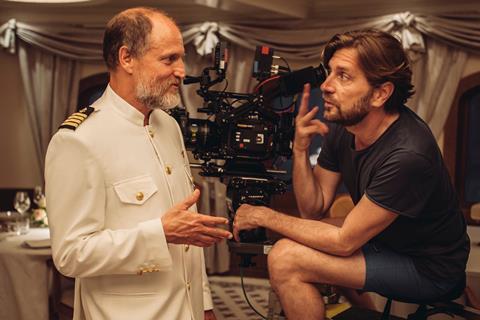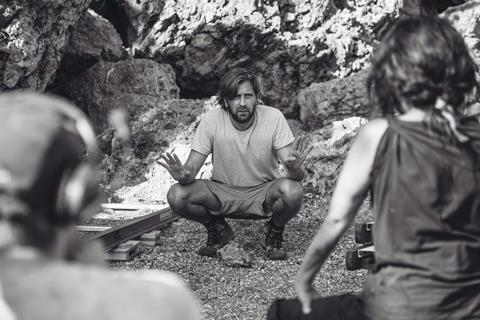Ruben Östlund is the director who loves to make audiences squirm — and never more so than with his Palme d’Or-winning satire Triangle Of Sadness. He tells Demetrios Matheou what drives his cinema of discomfort

In another life, Ruben Östlund might have been a stand-up comedian, of the kind who makes his audiences squirm in their seats, fearful of becoming the next victim or embarrassed by the familiarity of the foibles being voiced onstage. Some might say he is the Ricky Gervais of Palme d’Or winners.
In Force Majeure, Östlund offered a dissection of a family in crisis; in The Square, a satire on the art world; and in Triangle Of Sadness, a skewering of the fashion industry and the uber-rich. In each, male ego receives a particular battering.
The Swedish director agrees wholeheartedly that he is trying to make audiences uncomfortable. “Definitely. To make movies is, in some ways, to challenge the audience and make them react — and to make that a collective feeling. Because if you’re sitting together and watching something that is challenging you, there’s also a social situation that you have to deal with,” he says.
“But first of all, I want to confront myself, the kind of opinions I have, or my behaviour. When I feel cornered by a situation, I love it.”
He also accepts the comparison with stand-up, while adding a dark twist. “Someone said my films are a cross between Michael Haneke and Larry David. And I felt, they are right. I was brought up with Seinfeld and the kind of American stand-up culture that very often describes everyday dilemmas, situations where we’re trying to avoid losing face or have problems with socialising, and so on. I can identify with that kind of situation-based humour.
“I think also of Candid Camera, because it has such a sociological approach to it. One person is dealing with a situation, a set-up, where the social contract is broken. You learn so much about how we behave.”

Formative years
This instinct comes from Östlund’s upbringing. His mother was a teacher with a keen interest in sociology. “She told me she did the Solomon Asch conformity test for her students in school, the group influence over the individual and so on. I have been very inspired by the way that you look at the world through sociology, showing how our behaviour can be influenced by its context.”
He was also affected by his mother’s political engagement. “She became left-wing during the 1960s and is still one of the few who considers herself a communist. My father was also left-wing in the 1960s, though he would not say he’s a communist anymore. My brother is a right-wing liberal, and maybe I’m somewhere in between. In my home, we always have had very loud political debates.”
Those family tussles may well inform one particular scene in Triangle Of Sadness, between Woody Harrelson’s communist ship captain, and Zlatko Buric’s oleaginous Russian oligarch, who drunkenly exchange ideological aphorisms while the pampered passengers vomit up the seven-course captain’s dinner during a storm.
The film’s satire is at its most enjoyable when Östlund is dismantling his group of heinous billionaires at sea. But the dining scene came with unusual challenges, whether safely calibrating the spectacular rocking of the dining room, set on a gimbal, or having actors pretend to throw up at a time when the pandemic had forced most people to wear masks.
“Maybe the most awkward thing was when we were shooting the vomiting scene during Covid, because everybody was afraid,” says Östlund. “We didn’t know how dangerous this pandemic was, and the fact everyone was coughing and [retching] was so connected with what we were afraid of. I don’t know if it improved the scene, or made it less extreme.”
He explains the memorable cruise sequence was primarily a means to an end, taking the modelling couple at the heart of the film to the desert island where he expands on his principal theme, the notion of beauty as social currency. As castaways, the power dynamic between passengers and crew is subverted when it becomes clear the ship’s cleaner is the only one who can fish, and the male model becomes her lover for a larger share of the catch.

Inside knowledge
The filmmaker’s interest in models started with his partner, who is a fashion photographer. “When we met, she told me very interesting things about her profession,” he says. “For example, the male models are earning maybe only a third as much as the female models [something that informs an early scene]. And when I started to research, numerous male models told me they often have to manoeuvre past powerful men in the industry who want to sleep with them, sometimes with the promise of a more successful career. In some respects, being a male model mirrors what women have to deal with in a patriarchal society.
“The film was partly written during the MeToo movement,” Östlund continues. “I thought it was problematic to discuss sexuality and beauty as currency from a female perspective. So, wow, great, let’s do it from a male perspective. Everybody who has this currency is aware of it, because we are human beings and have been trained in socialising since we were born. It’s strange we don’t talk about it.”
Östlund has now made three films in succession with DoP Fredrik Wenzel, production designer Josefin Asberg and supervising sound editor Andreas Frank, collaborations that he describes as constantly developing and improving, “because all of us want to push it further the next time”.
And he reflects on another collaborator, South African actress and model Charlbi Dean, who died three months after the film’s Cannes premiere, aged just 32. “It’s a tragedy for everybody who knew her. She had been working as a model since she was 14 years old. To be a model, there’s a lot of prejudice, like, for example, that you’re not a good actress. And she was an excellent actress. I’m just happy we got to share Cannes together, because she was so happy and proud about that.”
Triangle Of Sadness is Östlund’s first English-language film, and his second to win the Palme d’Or after The Square in 2017. It was produced by Plattform Produktion (which he founded with producer Erik Hemmendorff in 2002) alongside Essential Films and Coproduction Office. Triangle Of Sadness has grossed more than $16m at the global box office since it rolled into cinemas in late September, including $4m in North America at press time for Neon, outstripping The Square. And the film swept the European Film Awards in December, winning European film, director and screenplay for Östlund and actor for Buric.
For Östlund, Plattform Produktion is a project that also has a kind of family influence. His paternal great-grandfather was one of the founders of Swedish avant-garde art collective Halmstadgruppen, whose members worked together for 50 years. Östlund sees his company, which includes several filmmaking friends, in a similar light.
“I’m often asked what my aim is. It’s not the Golden Palm,” he laughs. “We’ve said that we should also work together for 50 years. That’s our goal. I think we have a specific approach to producing and doing cinema in Sweden. To really make our mark, it would be fantastic to work collectively for a long time, getting old together, getting to know each other in a way that we can create a movement for all of us.”























No comments yet